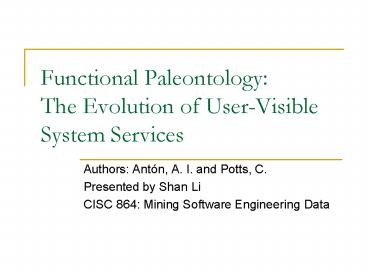Functional Paleontology: The Evolution of User-Visible System Services - PowerPoint PPT Presentation
Title:
Functional Paleontology: The Evolution of User-Visible System Services
Description:
To propose an approach: functional Paleontology. Paleontology: the study of the forms of life existing in ... Such as paleontology, morphology, langue. ... – PowerPoint PPT presentation
Number of Views:133
Avg rating:3.0/5.0
Title: Functional Paleontology: The Evolution of User-Visible System Services
1
Functional PaleontologyThe Evolution of
User-Visible System Services
- Authors Antón, A. I. and Potts, C.
- Presented by Shan Li
- CISC 864 Mining Software Engineering Data
2
Outline
- Discussion of the paper
- Contributions of the paper
- Purposes, examples, results, significance
- The approach used in the paper
- Personal Perspectives
- Pleasant points in the paper
- Unpleasant points in the paper
- Conclusion Questions
3
Before the Discussion
Requirements
4
What is needed to be known?
- The balance between in forward engineering and
reverse engineering is about the requirements
which emphasized in forwarding engineering, while
de-emphasized in reverse engineering.
5
The Research Purpose
To redress the balance
To discuss the implication of general patterns
of functional evolution for forward engineering
To achieve the general patterns of functional
evolution
6
Research Methods
- To restrict the study to the functionality
evolution - To propose an approach functional Paleontology
- Paleontology the study of the forms of life
existing in prehistoric times, as represented by
the fossils of plans, animals and other organisms - Analyzing fossil record of service evolution for
a single system - Services collections of functions related to
purposes or mode of use
7
Research Methods
- To characterize evolution in systems, based on
Shaws classification scheme for software
engineering research
8
Research Methods
- To investigate into fossil record in an example
- The telephony services available to domestic
subscribers over a 50-year period - Specifically, services contained in the call
guide of the Atlanta telephone directories for
the years 1950-1999 - To study the profile of services benefits and
burdens in a systems evolution
9
Research Methods
- To develop a conceptual base
- Functional morphology
- Overall profile of benefits and burdens exhibited
by a system during its evolution - Benefits system-use outcomes which meet a
beneficiarys goals - Burdens which undermine these benefits
- Functional evolution
- Vocabulary of Evolutionary types
10
Research Results
- The results of the telephony services evolution
- Categories of Benefits
- Categories of Burdens
- Service Epochs and Expansions
- Punctuated Evolution Pattern
- Periodic Retrenchment
- Functional Decentralization
11
Research Results
Benefits profile over 50 years From 1950-1999
12
Research Results
Burden profile over 50 years From 1950-1999
13
Research Results
- The evolution of telephony services suggests two
general trends - Benefits for the actor beneficiary precede
benefits for others - Services initially benefits the people who
actually perform tasks - Object-level benefits precede meta-level benefits
- Object-level the creation and transfer of
information - Meta-level how the system is manipulating
information
14
Research Results
- Customization features may be relatively
unimportant in most systems. Lets put it other
way, user customization may be significantly
limited by the legacy of core design decisions - The approach is relevant to the management of
long-life software systems.
15
Future Research
- Feasibility Questions
- Is it possible to relate the functional
morphology of the system in question to the
software architecture? - Characterization Questions
- Method Questions
- Generalization Questions
- Selection Questions
16
Personal Perspective
- Pleasant Points
- The paper has excellent structure and describes
their research method from the general level to
case study level and explains their discoveries
from case study level to the general level - The paper defines every terms used.
- The paper restricts the study into an aspect of a
system - The paper discusses the disadvantages of the
results based on the limited data
17
Personal Perspective
- Unpleasant Points
- The paper borrows many terms from other
disciplines, biology, engineering, linguistics. - Such as paleontology, morphology, langue..
- The paper does not emphasize the implication of
the results for forward engineering of software
engineering, which is one of the purpose of the
paper.
18
Conclusion
- Contribution of the paper
- Proposed a new methodology, generalized their
approach by applied to most systems dominated by
dynamic information systems problem frame. - The approach is therefore relevant to the
management of long-life software systems - The research is not only for software systems,
but also for others
19
Thank You Questions































